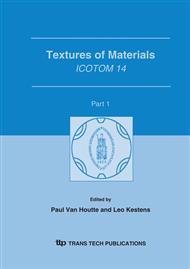p.737
p.743
p.749
p.755
p.761
p.767
p.775
p.785
p.791
A Study of the Early Stages of Recovery in Cold Rolled {110}<001> Oriented Copper Single Crystals
Abstract:
Copper single crystals of {110}<001> crystallographic orientation were cold rolled to a true strain of 1.4. Specimens were cut from the as-deformed crystals with all surfaces mechanically ground and deep-etched in concentrated nitric acid to minimise the likelihood of surface nucleation of recrystallized grains during subsequent annealing. The early stages of static recovery were studied by annealing specimens at 300 oC. The crystallographic features of the deformed and annealed microstructures were determined by high resolution electron backscatter diffraction. It was observed that deformation was homogeneous with the microstructure in ND-RD plane exhibiting two complementary sets of intersecting bands at ~+ 35o to ND. Along these bands and in the microstructure, in general, there was an overall spread in orientation about ND towards {110}<112>. However, the orientation spread along these bands was cyclic, that is, sinusoidal orientation gradients were generated about ND with amplitude of up to 20o and wavelength 5-10 µm. Annealing resulted in the preferred growth of cells that have orientations at the edge of the orientation spread of the deformation substructure. This localized coarsening of the microstructure is similar to the discontinuous subgrain growth observed in {110}<001> oriented Al single crystals and indicates that discontinuous subgrain (cellular) growth can also occur in metals of lower stacking fault energy.
Info:
Periodical:
Pages:
761-766
Citation:
Online since:
September 2005
Authors:
Price:
Сopyright:
© 2005 Trans Tech Publications Ltd. All Rights Reserved
Share:
Citation:


